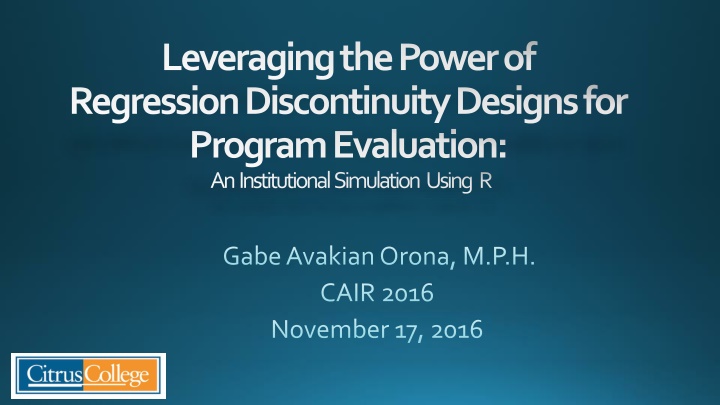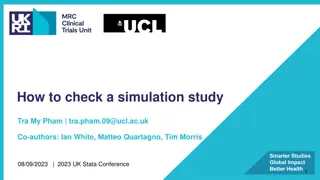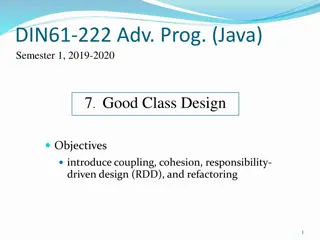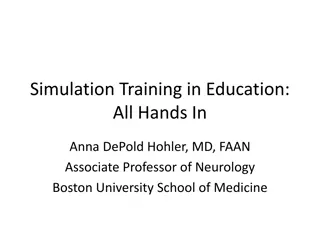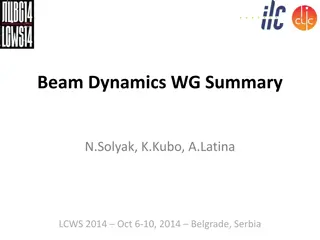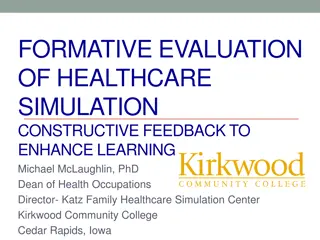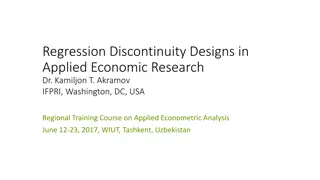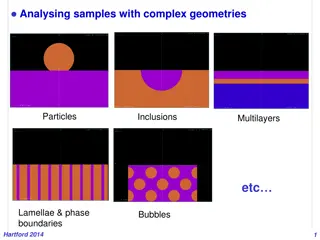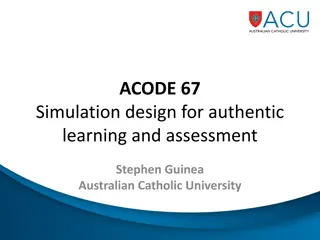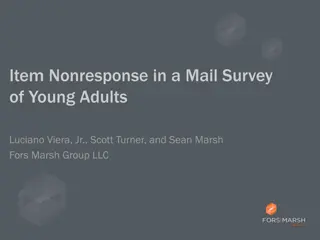Harnessing RDD in Program Evaluation: An R Simulation
Explore the application of Regression Discontinuity Design (RDD) for program evaluation through an institutional simulation in R. The study by Gabe Avakian Orona delves into the intricacies of RDD methodology and showcases how to implement it using the statistical tool R. Gain insights into leveraging RDD techniques for assessing program impact.
Download Presentation

Please find below an Image/Link to download the presentation.
The content on the website is provided AS IS for your information and personal use only. It may not be sold, licensed, or shared on other websites without obtaining consent from the author.If you encounter any issues during the download, it is possible that the publisher has removed the file from their server.
You are allowed to download the files provided on this website for personal or commercial use, subject to the condition that they are used lawfully. All files are the property of their respective owners.
The content on the website is provided AS IS for your information and personal use only. It may not be sold, licensed, or shared on other websites without obtaining consent from the author.
E N D
Presentation Transcript
Leveraging the Power of Regression Discontinuity Designs for Program Evaluation: An Institutional Simulation Using R Gabe AvakianOrona, M.P.H. CAIR 2016 November 17, 2016
Goals for today: Introduce Regression Discontinuity Design (RDD) Introduce R Simulate an RDD using R Encourage the use of this technique and R at your home campus 2
Regressionso what? Ideal for situations when there is a cut-score in which subjects above/below a threshold receive program resources or an intervention The variable used to determine the threshold is called the rating or "forcing variable. Examples: Accuplacerscores, GPA, household income Quasi-experimental design used to estimate the rigor and validity of a Randomized Control Trial (RCT) The Dept of Edu (2011) considers regression discontinuity to be one of the most rigorous quasi- experimental methods 3
Internal Validity 3. Imprecise Control No one single entity or factor should determine a rating score For instance, a committee vs. an individual 4. Clear discontinuity for treatment status at the cut-point Not too relevant for today 5
Types of Regression Discontinuity Designs (RDD) With regard to Treatment Assignment: Sharp Design: Where the cut-point perfectly predicts who does/doesn t receive intervention Fuzzy Design:Where there exists cross-overs (for various reasons) With regard to Analytic Approach: Non-parametric: local randomization approach Parametric: uses every observation in the sample Today we will be employing a sharp, non-parametric RDD 6
The Scenario The STEM grant director wishes to administer supplemental instruction (SI) exclusively to students who have GPAs below a certain level. A team of experts establish a GPA cut-point prior to viewing any actual data. A threshold of 2.5 is established: students below this cut-point will receive SI, those above will not. The director wants to determine if acute semester administration of SI proves effective in relation to final grade (numeric). 7
Typical Intervening Mechanism in Program Evaluation, Program Theory STEM Supplemental Instruction 7
Typical Intervening Mechanism in Program Evaluation, Program Theory Enhanced Study Skills/Content Clarification STEM Supplemental Instruction 8
Typical Intervening Mechanism in Program Evaluation, Program Theory Enhanced Study Skills/Content Clarification STEM Supplemental Instruction Semester Final Grade 9
Direct Relationship, "Program Theory STEM Supplemental Instruction Semester Final Grade 10
Simulation Data Institutional Data: -Taken from supplemental instruction STEM report, N = 589 -Scores are adjusted on outcome for demonstration purposes 8
Simulation Data Rating Variable: Preexisting GPA (GPA) (ri) Cut-Point: GPA of 2.5 (Ti) Outcome: Final Grade (0 4) (y) 9
Model ??= ? + ?0??+ ?1??+ ? Relationship between GPA and Final Grade Individual scores on the rating variable (GPA; centered) Estimated marginal mean Treatment status (0,1) Marginal impact of program 10
Counterfactual Framework What would have been for control students if they had received treatment Counterfactual Outcomes Counterfactual Outcomes What would have been for treated students if they had not received the treatment 11
Conceptual Framework Control Group Treatment Group 12
Conceptual Framework Discontinuity Local Randomization Bandwidth 13
What determines the bandwidth? There are several methods to determine the bandwidth for purposes of a local linear regression: 1. Visual Inspection of forcing variable/Manual 2. Statistical Recommendation/Automatic: a) Cross-Validation Technique b) Imbens and Kalyanaraman (IK) ,2009: Plug In procedure *In this simulation, we will be using IK technique 14
What determines the bandwidth? There are several methods to determine the bandwidth for purposes of a local linear regression: 1. Visual Inspection of forcing variable/Manual 2. Automatic/Statistical Recommendation: a) Cross-Validation Technique b) Imbens and Kalyanaraman (IK) (2009): Plug In procedure *In this simulation, we will be using IK technique, as this is automatically generated within the function used in todays analysis 14
What determines the bandwidth? There are several methods to determine the bandwidth for purposes of a local linear regression: 1. Visual Inspection of forcing variable/Manual 2. Automatic/Statistical Recommendation: a) Cross-Validation Technique b) Imbens and Kalyanaraman (IK) (2009): Plug In procedure *In this simulation, we will be using IK technique, as this is automatically generated within the function used in todays analysis 14
Downloading R https://www.r-project.org/ -R https://www.rstudio.com/ -R studio 15
How Rworks Download a package: Require it: Use the functions in the package: 17
How Rworks 3. Use the functions in the package: Object Name<- function(object) 18
How Rworks 3. Use the functions in the package: Object Name<- function(object) 18
How Rworks 3. Use the functions in the package: Object Name<- function(object) 18
How Rworks 3. Use the functions in the package: Object Name<- function(object) 18
How Rworks 3. Use the functions in the package: Object Name<- function(object) 18
RDD in R Step 1: Determine the bandwidth Step 2: Specify the model Step 3 : Run the analysis 19
RDD in R Step 1: Determine the bandwidth Step 2: Specify the model Step 3 : Run the analysis 19
RDD in R Step 1: Determine the bandwidth Step 2: Specify the model Step 3 : Run the analysis 19
RDD in R Step 1: Determine the bandwidth Step 2: Specify the model Step 3 : Run the analysis 19
RDD in R Step 1: Determine the bandwidth Step 2: Specify the model ??= ? + ?0??+ ?1??+ ? Step 3 : Run the analysis 19
RDD in R Step 1: Determine the bandwidth Step 2: Specify the model Step 3 : Run the analysis 19
RDD in R Step 1: Determine the bandwidth Step 2: Specify the model Step 3 : Run the analysis 19
RDD in R 20
RDD in R 20
McCrary Test A test of internal validity Alternative Hypothesis: Density is discontinuous around the cut- point 22
McCrary Test 23
Linear Regression Assigning Groups: 24
Linear Regression Assigning Groups: Specifying the linear model: 24
Linear Regression Assigning Groups: Specifying the linear model: Obtaining the output: 24
Linear Regression Assigning Groups: Specifying the linear model: Obtaining the output: 24
RDD vs. MLR Treatment Effect in RD analysis: 1.45 Treatment Effect in MLR analysis: .81 1.45 -.81 = .64 difference in treatment effect *When talking about final grade, this is quite a difference! 25
Conclusion Cursory presentation of RDD: Some theory and mathematics were presented You have the framework to dive deeper We covered a sharp, non-parametric RDD; consider fuzzydesigns and parametric analysis Regarding R: Steep learning curve, however this gentle introduction to the basic mechanics (packages functions objects) Plenty of R resources (Just Google, they are everywhere) 26
Recap Benefits of RDD: Rigor of RCT using an observed variable Useful method for program evaluation when there is a threshold determining participation Useful for education field Can be retrospective or prospective Benefits of using R: It s free Can be more efficient than other software (SPSS, etc) Can handle more complex analyses Multiple working datasets It s free!!! 27
References Flaster, A., & DesJardins, S. L. (2014). Applying Regression Discontinuity Design in Institutional Research. New Directions for Institutional Research, 2014(161), 3-20. Jacob, R. T., Zhu, P., Somers, M. A., & Bloom, H. S. (2012). A practical guide to regression discontinuity(pp. 1-91). New York: MDRC. U.S. Department of Education. (2011). What Works Clearinghouse: Procedures and standards handbook (version 2.1). Washington, DC: Author. Retrieved from : http://ies.ed.gov/ncee/wwc/pdf/reference_resources/wwc_procedures_v2_1_standards_handbook.pdf Lee, H., & Munk, T. (2008). Using regression discontinuity design for program evaluation. In Proceedings of the 2008 Joint Statistical Meeting(pp. 3-7). Imbens, G. W., & Lemieux, T. (2008). Regression discontinuity designs: A guide to practice. Journal of econometrics, 142(2), 615-635. Schochet, P., Cook, T., Deke, J., Imbens, G., Lockwood, J. R., Porter, J., & Smith, J. (2010). Standards for Regression Discontinuity Designs. What Works Clearinghouse. Melguizo, T., Bos, J. M., Ngo, F., Mills, N., & Prather, G. (2015). Using a regression discontinuity design to estimate the impact of placement decisions in developmental math. Research in Higher Education, 1-29. Stigler, M., & Quast, B. (2015). Package rddtools . 28
